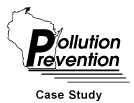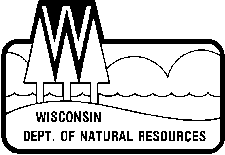
|
Kroy Incorporated
Reduction of Solvents in Adhesives
and Cleanup Solutions Used in Production of Printed Plastic Film Products |
| Standard Industrial Classification
(SIC) |
Coating and laminating paper and plastic
films/2671. |
| Type of Waste |
Adhesives and inks: Methyl ethyl
ketone-based |
| Strategy |
Material Substitution. |
| Company Background |
Kroy Incorporated has locations in
Scottsdale, Arizona, Osceola, Wisconsin; St.Croix Falls, Wisconsin; and Reading, England
(United Kingdom). Kroy manufactures world class thermal transfer lettering machines and
sign systems. Kroy sells machines worldwide through a network of dealerships. The company
employs about 300 people. All coating and chemical handling operations are performed in
St. Croix Falls, Wisconsin. |
| Original Process |
Approximately one million square feet of
ink and adhesive coated films are processed through a combination of four coating lines
each month. In 1987, 100 percent of these processes used methyl ethyl ketone as the
carrying solvent. The majority of the solvent was released through stack emissions. In
1987, Kroy released 56.6 tons of volatile organic compounds (VOCs) into the atmosphere. |
| Motivation |
The process change provides safe working
conditions for Kroy employees and a cleaner environment for the surrounding communities.
These concerns were a greater motivator than regulations. |
| Pollution Prevention Process |
Water-based adhesives replaced
40 percent of the solvent systems used in the early stage of the program. That
replacement has now increased to greater than 70 percent of all processes.
Proportionately, hazardous waste quantities did not decrease significantly; instead, the
toxicity of the waste was reduced. The water-based waste is incinerated (after the water
is removed) while 90 percent of the methyl ethyl ketone stream's solvent waste is
reclaimed (Ref: Waste Research and Reclamation (WRR) in Eau Claire, Wisconsin). |
| Stage of Development |
Kroy's pollution prevention program began
in 1988 and is currently in full operation. |
| Level of Commercialization |
The water-based adhesive is readily
available and considered public knowledge for use by other businesses. |
| Material/Energy Balance |
Original Process
Feedstock
Usage of methyl ethyl ketone, ethyl acetate isopropyl alcohol, hexane and heptane
combined for use in inks and adhesive resins was 160,000 lbs./year.Waste
Annual emissions were 113,000 lbs., with 47,000 lbs. in hazardous waste.
Disposal
Air emissions and hazardous waste.
Pollution Prevention Process
Feedstock
- Over a five-year period, the combined solvent usage for inks and resins
was reduced to 24,420 lbs/year.
- The balance of coated papers and films are coated with water-based
adhesive and top coats.
Waste
- 27,000 lbs.; 70 percent of the waste stream is methyl ethyl
ketone.
- Zero emissions; no hazardous waste.
Disposal
- Ninety percent of methyl ethyl ketone reclaimed & sold by Waste
Research and Reclamation.
- Remainder is incinerated by Waste Research and Reclamation.
|
| Economics |
Capital Costs
No additional equipment was necessary to implement this change.Operation/Maintenance
Costs
Methyl ethyl ketone usage for clean-up was reduced by 50 percent and replaced with
soap and water. Raw material costs were reduced by 16.5 percent. There was no
significant reduction in energy costs. The waste that is reclaimed by WRR is not charged
back to Kroy.
Payback Period
Immediate |
| Benefits |
Emissions were reduced by 77 percent
in the last five years. Employee exposure to VOCs was reduced. |
| Obstacles |
High performance requirements of specific
industrial applications compels Kroy to continue with some solvent-based resins and inks.
As technology improves, appropriate changes to non-hazardous materials will occur. |
| Company Address |
Kroy Incorporated
108 Industrial Drive
P.O. Box 459
Osceola, Wisconsin 54020 |
| Contact Person |
Steve Luchio, Process Engineer
715/483-3249
715/483-3017 FAX |
| Pollution Prevention Resources |
Free, On-site Technical Assistance
University of Wisconsin Extension
Solid and Hazardous Waste Education Center
Milwaukee area: 414/475-2845
Remainder of state: 608/262-0385Pollution Prevention
Information Clearinghouse
Wisconsin Department of Natural Resources
Hazardous Waste Minimization Program
608/264-8852, 608/267-9523 or 608/267-3763 |
 |
Bureau of Cooperative Environmental Assistance
Wisconsin Department of Natural Resources
P.O. Box 7921
Madison, WI 53707
608/267-9700
PUBL-TS-019 94 |
|

